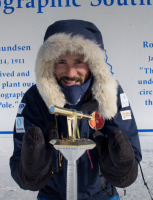Terrestrial Biodiversity
Climate Change
Mountains, Glaciers, Tundra & Permafrost
Climate Adaptation & Resilience
Wildlife & Invasive Species
Post-Doctoral Fellowships
Canada
Assessing The Combined Effect of Climate Change And Herbivores' Activities On Ohe Tundra
Studying Alpine plants of the Canadian Yukon, he is assessing the effects on plants of removing their neighbors, pruning a full third of their leaves to simulate grazing, and examining the impact of actual grazing by small mammals called pikas. Pikas live only about 5 years, but, across generations, their grazing can go on for decades. Measuring plants’ total biomass in the end reveals who is “winning” this complex competition. Dr. Bueno’s approach combining climate- and herbivore-induced changes goes further than past studies by identifying the precise mechanisms at play. His work could help predict for this and other ecosystems the risks of a changing climate.
Reading Plants’ Future in a Changing Climate
To add or modify information on this page, please contact us at the following address: community.research@axa.com

Guillermo
C.BUENO
Institution
University of Alberta
Country
Canada
Nationality
Spanish
Related articles
Climate Change
Finance, Investment & Risk Management
Societal Challenges
Climate Adaptation & Resilience
Insurance & Risk Management
Environmental Justice
Civil Society & Governance
AXA Project
Italy
AXA Research Lab on Climate Change, Risk and Justice
In response to three research questions: How can the private and financial sectors contribute to a just transition to a... Read more

Gianfranco
PELLEGRINO


